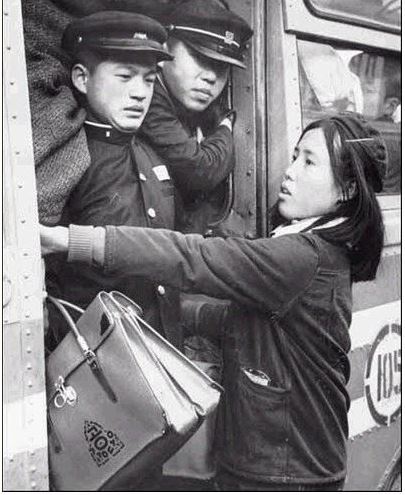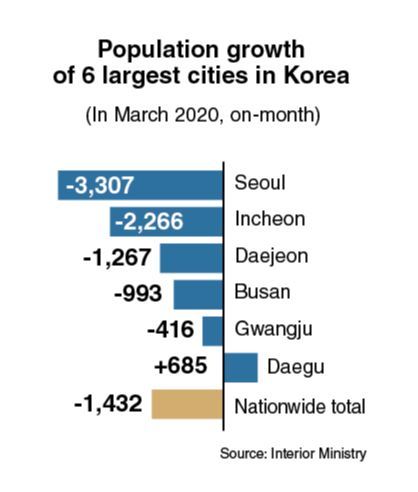 |
This photo, involving a transit bus attendant clinging to the door, shows tremendous growth in the number of Seoul citizens in the 1970s. But the capital sees its population decline 570,000 in less than a decade to 9.73 million as of March. (National Archives of Korea) |
SEJONG -- South Korea’s population declined by 1,432 to 51.843 million as of March, posting a fall for the fourth consecutive month, according to the Ministry of Interior and Safety.
Though the pace in population decrease has slowed, data shows that a historic inverse in Korea’s demographic trend is underway, which started in December. Compared to November, when the number of residents peaked at 51.851 million, the population has declined by 8,232 over the past four months.
The monthly demographic data include figures for changes in Korean citizenship as well as births and deaths.
Last month, out of the nation’s 17 major areas (eight cities and nine provinces), 14 including Seoul posted a negative growth on-month. Only three -- Gyeonggi Province, Sejong and Daegu -- recorded a positive growth.
North Gyeongsang Province topped the list as the number of its residents dipped by 5,538 in March. (In February, the region recorded the second-largest fall among the 17 areas with minus 3,552). South Gyeongsang Province posted minus 3,487 (ranked 2nd), followed by Seoul with minus 3,307 (third).
Seoul, which posted rebound for two consecutive months in January and February, suffered a slide again last month to record 9.733 million.
In March 2011, Seoul had 10.30 million registered residents, but the capital’s population has seen a steady decline since then. It recorded 10.14 million in March 2014, 9.92 million in March 2017, 9.83 million in March 2018 and 9.77 million in March 2019. In May 2016, the number fell below 10 million for the first time in 28 years, while the Seoul population had hovered over 10 million since 1988.
 |
(Graphic by Kim Sun-young/The Korea Herald) |
A significant number of former Seoul citizens are estimated to have moved to Gyeonggi Province and Incheon (both of which have many commuters to the capital), or to Sejong (the nation’s new administrative city) over the past decade.
South Jeolla Province and Incheon ranked fourth with minus 2,604 and fifth with minus 2,266, respectively. Incheon, nevertheless, saw its population continue to gain over the past decade, on the back of its new residential districts such as Songdo, Yeongjong, Cheongna and Geomdan.
Among the other major cities, minus 993 in population was reported in Busan, minus 1,267 in Daejeon, minus 416 in Gwangju and minus 1,147 in Ulsan.
In contrast, Gyeonggi Province marked a month-on-month increase by 23,598 to reach an all-time high of 13.288 million. The number of residents in Sejong climbed by 1,004 to 344,792, which is a record-breaking surge (97.1 percent growth) compared to five years earlier in March 2015, when it stood at 174,920.
Daegu also gained population by 685 to 2.433 million in March. But the city saw the number of deaths from COVID-19 exceed 110 over the past two months.
In March, the number of deaths outstripped the number of births -- 26,873 vs. 25,971. While the disparity between the two was 902, citizenship changes -- that is, Koreans renouncing their citizenship and foreigners acquiring citizenship -- extended the population decline, for a total decline of 1,432 (minus 1,748 for men and plus 316 for women).
The women’s population rose again (by 316) in March after posting a negative growth for the two consecutive month -- minus 399 in January and minus 510 in February.
The male population declined for the eighth consecutive month for a cumulative figure of minus 9,895 during the August 2019-March 2020 period.
“Korea’s fertility rate is the lowest in the world, at 0.85 as of the fourth quarter of 2019. As the Interior Ministry data showed, we have already entered the era of steady loss in population and are facing a demographic cliff,” said an official at Government Complex Sejong.
The nation, previously, had seen negative population growth only twice, in March 2008 and April 2009. And for a decade between May 2009 and November 2019, the population continually increased on-month, with the exception of several dips in male population.
Meanwhile, the nation’s female residents outnumbered its male residents by about 125,000 as of last month -- a disparity of 25.984 million vs. 25.858 million across the nation.
The sex ratio, or the number of men per 100 women, posted an all-time low of 99.5, compared with 10 years earlier in March 2010, when it reached 100.3.
By Kim Yon-se (
kys@heraldcorp.com)









